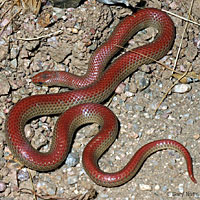|
| Orange-Striped Morph |
 |
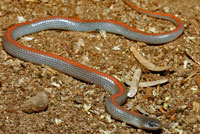 |
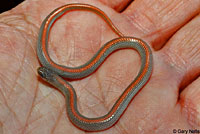 |
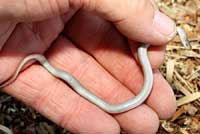 |
| |
Juvenile, Imperial County |
|
| |
 |
|
| |
Juvenile, Imperial County |
|
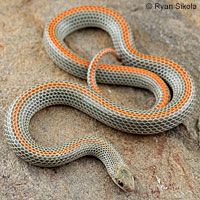 |
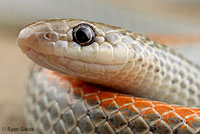 |
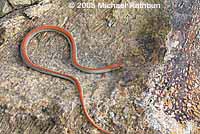 |
| Adult, Inyo County © Ryan Sikola |
Adult, Old Woman Mtns.
San Bernardino County
© 2005 Michael Rathbun. |
 |
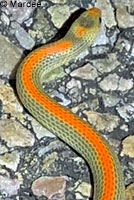 |
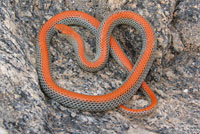 |
Adult, Inyo County © Mardee
Another groundsnake with the same coloring as this one but with bright orange saddles instead of a stripe was also found in the same area. (Shown below)
|
Adult, Old Woman Mountains, San Bernardino County
© Jeremiah Easter |
| |
|
|
| Orange-Striped Black-Banded Morph |
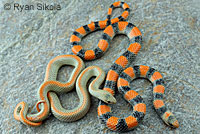 |
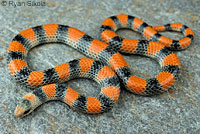 |
 |
Striped and banded adults, Inyo Couty
© Ryan Sikola |
Adult, Inyo Couty © Ryan Sikola |
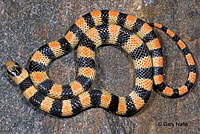 |
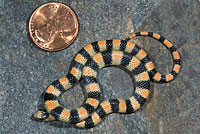 |
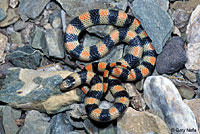 |
| Adult, Inyo County |
Adult, Inyo County |
 |
 |
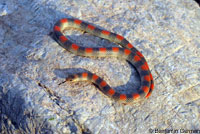 |
Adult, Lassen County
(First snake recorded from from Lassen County and Northeastern California.)
© Loren Prins
|
Adult, Inyo County
© Brad Alexander |
Adult, Clark Mountains, San Bernardino County. © Benjamin German |
 |
 |
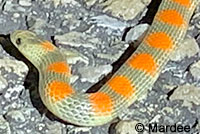 |
Striped adult male and banded adult female, San Bernardino County
© Adam G. Clause |
Adult, Inyo County © Mardee
This aberrant adult missing black pigment was found near another groundsnake with more typical coloring. Another groundsnake with the same coloring as this one but with an orange stripe instead of saddles was also found in the same area.
(Shown above.)
|
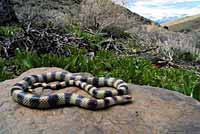 |
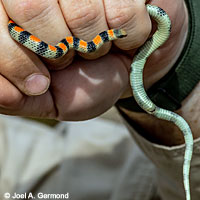 |
 |
Adult, Inyo County
© 2005 Jeremiah Easter |
Adult, showing partial dark banding of the underside, eastern San Bernardino County desert © Joel A. Germond |
Shed Groundsnake Skin, Inyo County |
| |
|
|
| Banded Morph |
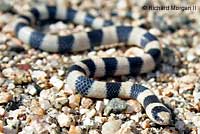 |
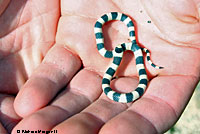 |
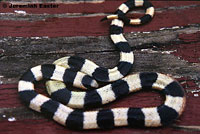 |
| Adult, Riverside County © Richard Morgan II |
Preserved specimen from the Bartlett Hills near the town of Joshua Tree, San Bernardino County. © Jeremiah Easter |
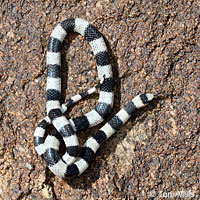 |
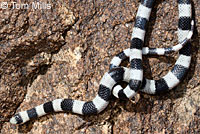 |
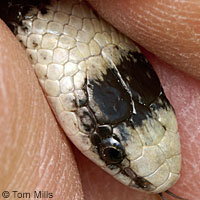 |
| Adult found active in daylight in the Riverside County desert © Tom Mills |
| |
|
|
| Variable Groundsnakes From Outside California |
| |
|
|
| Unicolor Morph |
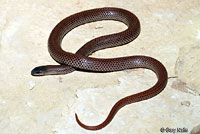 |
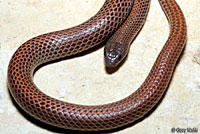 |
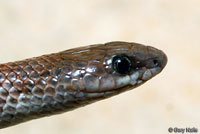 |
| |
Adult, Presidio County, Texas |
|
| |
| (The unicolor Variable Groundsnakes shown below have been tentatively described as the species Sonora episcopa.) |
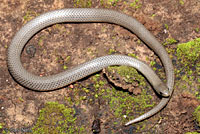 |
 |
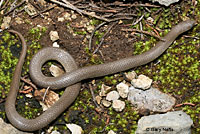 |
| Adult, Travis County, Texas |
Adult, Travis County, Texas |
| |
|
|
| (The unicolor Variable Groundsnakes shown below have been tentatively described as Sonora mosaueri) |
 |
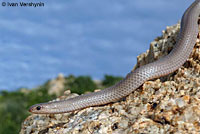 |
|
| Adult, Los Cabos, Baja California Sur © Ivan Vershynin |
|
| |
| Other Morphs |
 |
 |
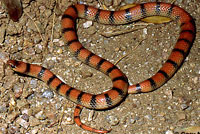 |
| Orange-striped black-banded adult, Washoe County, Nevada © Jeremiah Easter |
Orange-striped black-banded adult, Arizona© Gary Nafis, specimen courtesy of Randy Babb |
| |
|
|
| |
Wide orange-striped adult, Arizona,
© Gary Nafis, specimen courtesy of Randy Babb |
|
| |
| Habitat |
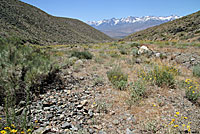 |
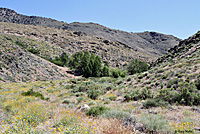 |
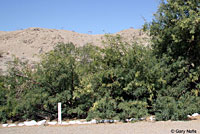 |
Habitat, rocky wash, 5,500 ft.,
Inyo County mountains
|
Habitat, White/Inyo Mountains,
Inyo County |
Habitat, next to Colorado River, Imperial County desert |
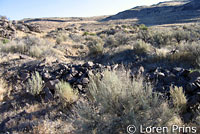 |
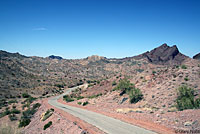 |
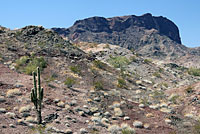 |
Habitat, Lassen County desert
© Loren Prins |
Habitat, Whipple Mountains, San Bernardino County |
 |
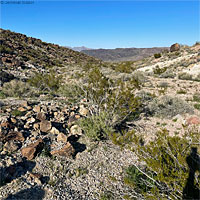 |
 |
Desert Riparian Habitat,
Inyo Mountains, Inyo County
|
Habitat, Amargosa Mountains, Inyo county © Jeremiah Easter |
A Groundsnake was found at a spring in the Kingston Mountains, seen here in the background, in San Bernardino County.
© Steve Bledsoe |
| |
|
|
| Short Video
|
| |
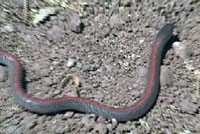 |
|
| |
A tiny juvenile Variable Ground Snake is found under a rock in Imperial County. |
|
| |
|
|
| Similar Sympatric Snakes |
Comparison chart of the 3 subspecies of Chionactis in California, along with the similar sympatric species - Sonora semiannulata, and the similar possibly sympatric species - Chilomeniscus stramineus.
A plain-colored Variable Ground Snake with black on the head is sometimes confused with a Smith's Black-headed Snake - Tantilla hobartsmithi, but the ground snake has a loreal scale, which is not present in Tantilla, and lacks the red coloring on the belly that is found on the black-headed snake.
|
 |
 |
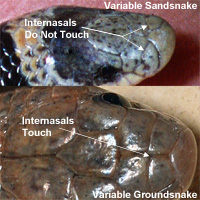 |
 |
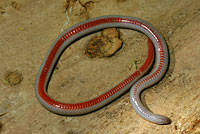 |
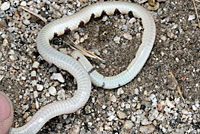 |
Underside of striped morph
Variable Groundsnake |
Underside of
Smith's Black-headed Snake |
Underside of
Shovel-nosed Snake |
|
|
Description |
Not Dangerous - This snake does not have venom that can cause death or serious illness or injury in most humans.
Commonly described as "harmless" or "not poisonous" to indicate that its bite is not dangerous, but "not venomous" is more accurate. (A poisonous snake can hurt you if you eat it. A venomous snake can hurt you if it bites you.)
There are shallow grooves on the outer sides of the rear teeth which indicates that this snake may produce a mild venom, but it is not dangerous to humans.
|
| Size |
Adults are typically 8 - 18 inches long (20.3 - 46 cm) (Stebbins, 2003.)
|
| Appearance |
A small snake with a round body, smooth glossy scales, and a head barely wider than the neck.
|
| Color and Pattern |
Variable in color and pattern.
The underside can be whitish or yellowish with or without dark crossbands.
Four different morphs are generally recognized, but there may be more:
- orange-striped (with very thin to very wide stripes)
- orange-striped-black banded (the orange coloring is on the top part of the body only, while the black bands extend to the venter.)
- banded (typically with black and white bands, sometimes they are rings circling the entire body.)
- unicolor (or "uniform" - often brown, tan, or gray, sometimes white or orange)
These markings do not vary between sexes or change with age.
Often several morphs are found in the same location.
Some examples of the various colors and patterns found in these morphs are:
- banded with black and gray or yellowish with or without reddish saddles along the back on the light bands
- solid gray or brown with a darker head
- banded with orange or red and black
- banded with white and black
- banded with pink and gray
- reddish-orange above with gray sides
- gray with a thin orange stripe along the back
|
| Life History and Behavior |
Activity |
Secretive but not uncommon.
Can be active any time of day or night. Desert populations become primarily nocturnal in hot months.
Becomes dormant in cold months, roughly November into February.
Terrestrial, often remaining underground in the daytime, surfacing at night or during heavy rains.
Sometimes seen on roads at night, often discovered beneath surface debris, especially rocks. |
| Diet and Feeding |
| Eats small invertebrates, including spiders, scorpions, centipedes, crickets, and insect larvae. |
| Predation |
| Ground snakes are probably consumed by various vertebrates, including snakes, mammals, and birds, and maybe large lizards, but their predators also include invertebrates: A large Scolopendra heros centipede was observed killing then eating a Ground Snake in Texas. (Herpetological Review 38(1), 2007) |
| Reproduction |
Mating takes place in May and early June.
Females are oviparous, laying eggs underground from late May to August.
Females have been observed laying from 1 - 6 eggs.
Incubation lasts about 60 days.
(Bartlett & Tennant, 2000)
|
| Habitat |
Inhabits areas with surface cover and some moisture: grassland, riverbottoms, desert flats, ranchland, sand hummocks, open rocky hillsides with loose soil, sandy washes, dry streambeds, and riparian thickets.
|
| Geographical Range |
In California, this species occurs from eastern San Diego county east to the Colorado River, north into the Mojave Desert as far west as 29 palms and Barstow, and north along the eastern slopes of the Sierra Nevada Mountains to Nevada, and farther north in Lassen County. (The first record from Northeastern California and from Honey Lake Basin in Lassen County was described in Herpetological Review 38(4), 2007, and can be seen in a photo above taken by Loren Prins, who made the discovery.)
Outside California, the species ranges north into Nevada, Oregon, and Idaho, extreme southeast Utah, Arizona, New Mexico, Texas, Oklahoma, Colorado, Arkansas, Missouri, and Kansas, and south into Mexico, including much of Baja California.
|

(Several subspecies are sometimes recognized, but I don't know their exact ranges outside of California.)
|
| Elevational Range |
Occurs from sea level to about 6,000 feet (1,830 m) elevation. (Stebbins & McGinnis, 2018)
|
| Notes on Taxonomy |
Several subspecies were once thought to exit based on the different pattern and color morphs found in this species, but when it was observed that several morphs were often found at the same location, this was considered inaccurate.
Cox et al in their April 2018 paper "Synopsis and taxonomic revision of three genera in the snake tribe Sonorini," synonymized genera Chilomeniscus and Chionactis with genus Sonora. They did not discuss common names changes.
If their taxomomy is accepted:
* Sonora semiannulata semiannulata becomes Sonora semiannulata;
* Chionactis occipitalis becomes Sonora occipitalis;
* Chionactis annulata annulata becomes Sonora occipitalis;
* Chilomeniscus stramineus, where possibly present in California, becomes Sonora cincta.
(Synopsis and taxonomic revision of three genera in the snake tribe Sonorini.
Christian L. Cox, Alison R. Davis Rabosky, Iris A. Holmes, Jacobo Reyes-Valasco, Corey E. Roelke, Eric N. Smith, Oscar Flores-Villela, Jimmy A. GcGuire and Jonathan A. Campbell.
Journal of Natural History, 2018 Vol. 52, Nos. 13-16, 945-988.
https://doi.org/10.1080/00222933.2018.1449912)
---------------------------------------------------------------------------------------------------------------------------------------------------------------------
Although most subspecies of Sonora are no longer recoginzed, the most current (2017) SSAR Standard English Names checklist continues to recognize two subspecies:
S. s. semiannulata Baird and Girard, 1853—Variable Groundsnake
S. s. taylori (Boulenger, 1894)—Southern Texas Groundsnake
Alternate and Previous Names (Synonyms)
Sonora semiannulata - Western Ground Snake (Stebbins 1966, 1988, 2003, 2012)
Sonora semiannulata - Western Ground Snake (2 subspecies in CA - S. a. isozona; S. a. linearis) (Stebbins, 1954)
S. s. isozona - Bicolored ground snake (Woodbury 1928)
S. s. linearis - Striped ground snake (Van Denburgh 1922)
Sonora episcopa - Texas Ground Snake (Lamprosoma episcopum)
Ringed ground snake
Banded ground snake;
Banded miter snake (refers to the head marking looking like a bishop's miter);
Bicolor ground snake;
Black banded ground snake;
Miter snake;
Pinkish ground snake;
Sonora ring snake;
Striped ground snake;
Vermilion ground snake;
Western earth snake
Vermilion-lined ground snake
Striped earth snake
Vermilion-striped ground snake
|
| Conservation Issues (Conservation Status) |
| None |
|
| Taxonomy |
| Family |
Colubridae |
Colubrids |
Oppel, 1811 |
| Genus |
Sonora |
North American Groundsnakes |
Baird and Girard, 1853 |
| Species |
semiannulata |
Western Groundsnake |
Baird and Girard, 1853 |
Subspecies
|
semiannulata |
Variable Groundsnake |
Baird and Girard, 1853 |
|
Original Description |
Sonora semiannulata - Baird and Girard, 1853 - Cat. N. Amer. Rept., Pt. 1, p. 117
from Original Description Citations for the Reptiles and Amphibians of North America © Ellin Beltz
|
|
Meaning of the Scientific Name |
Sonora - region of Sonora - type collected in Sonora, Mexico
semiannulata - Latin - semi - half and annulata - ringed - refers to the body cross bands which fail to cross the venter
from Scientific and Common Names of the Reptiles and Amphibians of North America - Explained © Ellin Beltz
|
|
Related or Similar California Snakes |
C. o. annulata - Colorado Desert Shovel-nosed Snake
C. o. occipitalis - Mojave Shovel-nosed Snake
C. o. talpina - Nevada Shovel-nosed Snake
C. stramineus - Variable Sandsnake
R. l. lecontei - Western Long-nosed Snake
|
|
More Information and References |
California Department of Fish and Wildlife
Stebbins, Robert C., and McGinnis, Samuel M. Field Guide to Amphibians and Reptiles of California: Revised Edition (California Natural History Guides) University of California Press, 2012.
Stebbins, Robert C. California Amphibians and Reptiles. The University of California Press, 1972.
Flaxington, William C. Amphibians and Reptiles of California: Field Observations, Distribution, and Natural History. Fieldnotes Press, Anaheim, California, 2021.
Samuel M. McGinnis and Robert C. Stebbins. Peterson Field Guide to Western Reptiles & Amphibians. 4th Edition. Houghton Mifflin Harcourt Publishing Company, 2018.
Stebbins, Robert C. A Field Guide to Western Reptiles and Amphibians. 3rd Edition. Houghton Mifflin Company, 2003.
Behler, John L., and F. Wayne King. The Audubon Society Field Guide to North American Reptiles and Amphibians. Alfred A. Knopf, 1992.
Powell, Robert., Joseph T. Collins, and Errol D. Hooper Jr. A Key to Amphibians and Reptiles of the Continental United States and Canada. The University Press of Kansas, 1998.
Bartlett, R. D. & Patricia P. Bartlett. Guide and Reference to the Snakes of Western North America (North of Mexico) and Hawaii. University Press of Florida, 2009.
Bartlett, R. D. & Alan Tennant. Snakes of North America - Western Region. Gulf Publishing Co., 2000.
Brown, Philip R. A Field Guide to Snakes of California. Gulf Publishing Co., 1997.
Ernst, Carl H., Evelyn M. Ernst, & Robert M. Corker. Snakes of the United States and Canada. Smithsonian Institution Press, 2003.
Wright, Albert Hazen & Anna Allen Wright. Handbook of Snakes of the United States and Canada. Cornell University Press, 1957.
John E. Werler and James R. Dixon. Texas Snakes: Idenification, Distribution, and Natural History. University of Texas Press, Austin. 2004.
Joseph Grinnell and Charles Lewis Camp. A Distributional List of the Amphibians and Reptiles of California. University of California Publications in Zoology Vol. 17, No. 10, pp. 127-208. July 11, 1917.
(Synopsis and taxonomic revision of three genera in the snake tribe Sonorini.
Christian L. Cox, Alison R. Davis Rabosky, Iris A. Holmes, Jacobo Reyes-Valasco, Corey E. Roelke, Eric N. Smith, Oscar Flores-Villela, Jimmy A. GcGuire and Jonathan A. Campbell.
Journal of Natural History, 2018 Vol. 52, Nos. 13-16, 945-988.
https://doi.org/10.1080/00222933.2018.1449912)
|
|
|
The following conservation status listings for this animal are taken from the January 2024 State of California Special Animals List and the January 2024 Federally Listed Endangered and Threatened Animals of California list (unless indicated otherwise below.) Both lists are produced by multiple agencies every year, and sometimes more than once per year, so the conservation status listing information found below might not be from the most recent lists. To make sure you are seeing the most recent listings, go to this California Department of Fish and Wildlife web page where you can search for and download both lists:
https://www.wildlife.ca.gov/Data/CNDDB/Plants-and-Animals.
A detailed explanation of the meaning of the status listing symbols can be found at the beginning of the two lists. For quick reference, I have included them on my Special Status Information page.
If no status is listed here, the animal is not included on either list. This most likely indicates that there are no serious conservation concerns for the animal. To find out more about an animal's status you can also go to the NatureServe and IUCN websites to check their rankings.
This snake is not included on the Special Animals List, which indicates that there are no significant conservation concerns for it in California.
|
| Organization |
Status Listing |
Notes |
| NatureServe Global Ranking |
|
|
| NatureServe State Ranking |
|
|
| U.S. Endangered Species Act (ESA) |
None |
|
| California Endangered Species Act (CESA) |
None |
|
| California Department of Fish and Wildlife |
None |
|
| Bureau of Land Management |
None |
|
| USDA Forest Service |
None |
|
| IUCN |
|
|
|
|






























































